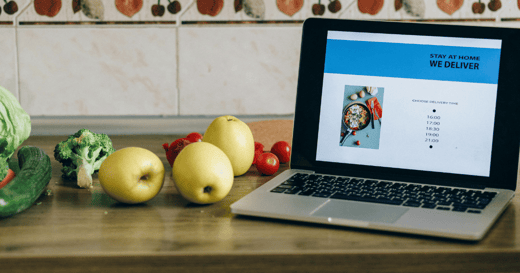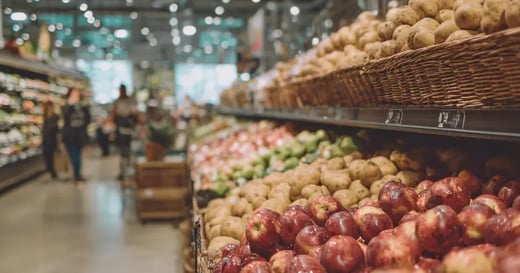Managing perishable produce is like juggling a dozen ticking time bombs, with each fruit and veggie set to explode (or turn to mush) at a different time.
Fortunately, produce inventory management doesn’t have to be this stressful.
In this blog, we’ll explore everything you need to know about managing delicate, perishable stock — including the tools you need, pro tips for tracking and stocking produce, proven waste prevention strategies, and more profit-protecting tips.
The Cost of Poor Produce Inventory Management
Industry experts estimate that grocery stores lose between 3% and 6% of their cost of goods sold (COGS) to spoilage.
If you fall into the average, you’ll lose between $2,400 and $4,800 to spoilage during an $80,000 month.
Where does your produce department come into this? Produce is one of the most profitable items you sell in your grocery store, with impressive margins between 25% and 40% — but it’s also the most susceptible to spoilage and waste.
Wilted cabbages, bruised apples, and mushy squash might seem like the cost of doing business, but throwing them away means money down the drain.
The good news is that improving your produce inventory management protects your bottom line. Plus, it can help you:
- Build customers’ trust: Customers trust you to provide the freshest produce in town. Shelves full of expired produce will cost you sales and push your customers to shop elsewhere.
- Adapt to seasonal demand: Stocking in-season produce like strawberries in the summer and cranberries in the winter delights customers, but it requires proactive inventory planning.
- Maintain food safety: Poor inventory management isn’t just bad for business — it can be dangerous. Failing to rotate produce or remove expired items from your shelves can spoil additional inventory or make customers sick.
In short, proper produce inventory management is foundational for grocery store profitability — so let’s explore how to do it.
1. Invest in the Right Tools
Want to get a handle on your produce inventory? The first step is knowing exactly what you have in stock and when it’s freshest.
Counting every bell pepper by hand and recording the numbers in a spreadsheet takes valuable time and leads to errors, which is why we recommend relying on inventory management software instead. This powerful tool:
- Gives you a real-time overview of your stock levels
- Lets you count and adjust inventory from the sales floor and beyond
- Tracks inventory batches to help you monitor freshness
- Alerts you when stock is low or near expiry
- Monitors shrinkage and spoilage rates
- Simplifies the purchase order and receiving process for easier restocking
With this data right at your fingertips, you can make more informed decisions on the fly to prevent produce spoilage and protect your profit margins.
Related Read: Grocery Store POS & Inventory Management Software: 6 Top Providers
2. Use Data To Forecast Demand
Seeing customer demand for produce without dealing with spoilage requires a special skill: seeing into the future.
In other words, you need to predict your customers’ shopping behavior using data.
Your point of sale (POS) system’s sales reports offer valuable insights into your customers’ favorite produce items, your average inventory turnover, and seasonal trends that should affect your stocking methods.
Here are a few examples of how demand forecasting should affect your produce orders:
- Did you run out of pumpkins early last fall? Consider placing a larger order at the beginning of the season, and plan to restock multiple times to prevent stockouts and jack-o’-lantern disasters.
- Do you frequently run out of organic salad mix while your traditional offerings turn brown? This should alert you to your customers’ growing interest in healthy, eco-friendly options. Consider expanding your organic offerings to align with their changing tastes.
- Tired of tossing squishy zucchini? That’s a sign you’re ordering too much. Adjust your minimum threshold for these frequently overstocked products to continue meeting customer demand without losing money to spoilage.
Digging into your sales data can help you make smarter produce stocking decisions and learn more about your customers’ wants and needs.
3. Display Produce Properly
Improper produce displays are another common culprit behind excessive spoilage.
Picture this: You’ve just restocked apples, with each fruit wedged perfectly into the stack. A customer approaches, admires, then reaches for one — and the entire tower topples.
Now, you have a jumbled display and hundreds of bruised apples.
This is why you should avoid overstocking your displays and instead restock more frequently throughout the day.
Plus, this frequent restock strategy makes it easier to maintain accurate inventory counts and spot spoiled items earlier.
Pro tip: Your sales reports can help you identify the best times of day to restock! For example, if your store is less busy during the late morning hours, you can take advantage of the lull and restock produce before the afternoon rush.
4. Adopt the FIFO Method
Your produce demand and sales are high — but so is spoilage. What’s going on?
If this scenario sounds familiar, you aren’t rotating your perishable inventory properly. The first in, first out (FIFO) method is critical for managing perishables like fruits, vegetables, dairy, and meat.
When you receive new stock, place it at the back of your shelves or on the bottom of your shelves, encouraging customers to purchase your oldest items first.
Inventory management software with built-in batch monitoring should help you maintain FIFO when restocking. You can track items by arrival date and ensure that their on-shelf display matches your records.
5. Leverage Strategic Discounts
Unfortunately, forecasting demand and ordering the perfect amount of produce every time is impossible. Even with the best planning, you might still end up with more blueberries on hand than you can sell.
So, what should you do?
A strategic discount can help you avoid spoilage and still turn a profit on near-expiry produce. Simply identify which items you want to promote, create signage to encourage customers to take advantage, and set up the discount in your POS system so that it automatically applies at checkout.
For example, you might offer a regular percentage-based discount like 20% off, a buy one, get one (BOGO) deal, or a bulk deal like three for $6.
Pro tip: Want customers to take advantage of these deals? Give them recipe ideas to use produce at any stage of freshness! For example, bananas with brown spots make the best banana bread. You can even create a bundle deal with the essential ingredients.
6. Build Strong Supplier Relationships
Hoping to become your neighborhood’s most reliable source of fresh, delicious fruits and vegetables? You and your suppliers have to be on the same page.
Building strong vendor relationships is crucial for inventory management. A great partnership ensures timely deliveries and quality produce in every single order.
Here are a few of our top tips for produce vendor management:
- Track supplier data: Your inventory reports help you detect vendors that frequently deliver low-quality or near-expiry produce — as well as identify your most reliable suppliers. From there, you can invest more in suppliers with reliable quality control.
- Diversify suppliers: Relying on a single supplier for all your produce is a recipe for disaster. If they deliver a late or low-quality batch of produce, you’ll lose sales and disappoint customers. Instead, build a relationship with multiple reliable suppliers to prevent delays and stockouts.
- Automate reordering: Tracking vendors and manually creating purchase orders takes valuable time, so consider automating these tasks through your grocery store software. Simply set a minimum threshold, and when stock levels drop below it, your system will automatically generate a purchase order.
Stocking quality produce in the right amounts is a team sport, so don’t overlook your vendor relationships in your inventory management plan.
Manage Produce Inventory Like a Pro With IT Retail
If you’re ready to save thousands of dollars each month by reducing spoilage, we’re here to help.
IT Retail is an all-in-one POS and inventory management solution designed to help grocers like you manage perishable stock, forecast demand, and make data-driven decisions to boost profitability. Our software includes:
- Real-time inventory tracking for weight-based and perishable items
- Integrated payment processing for quick, secure checkouts
- Built-in customer loyalty and promotions
- E-commerce integration to help you offer grocery pickup and delivery
- In-depth reporting and analytics
Take these tools for a spin by scheduling your live, personalized demo of IT Retail today.








 by Margaret Thacker
by Margaret Thacker


